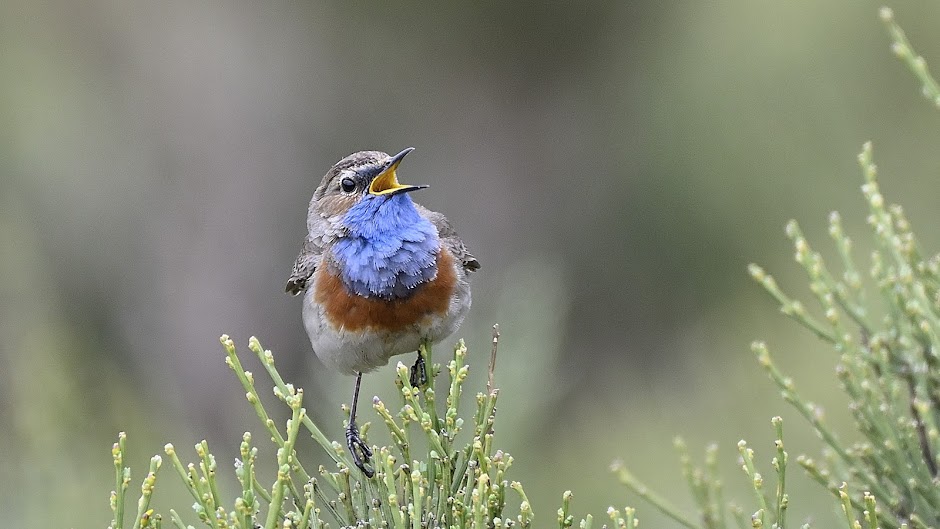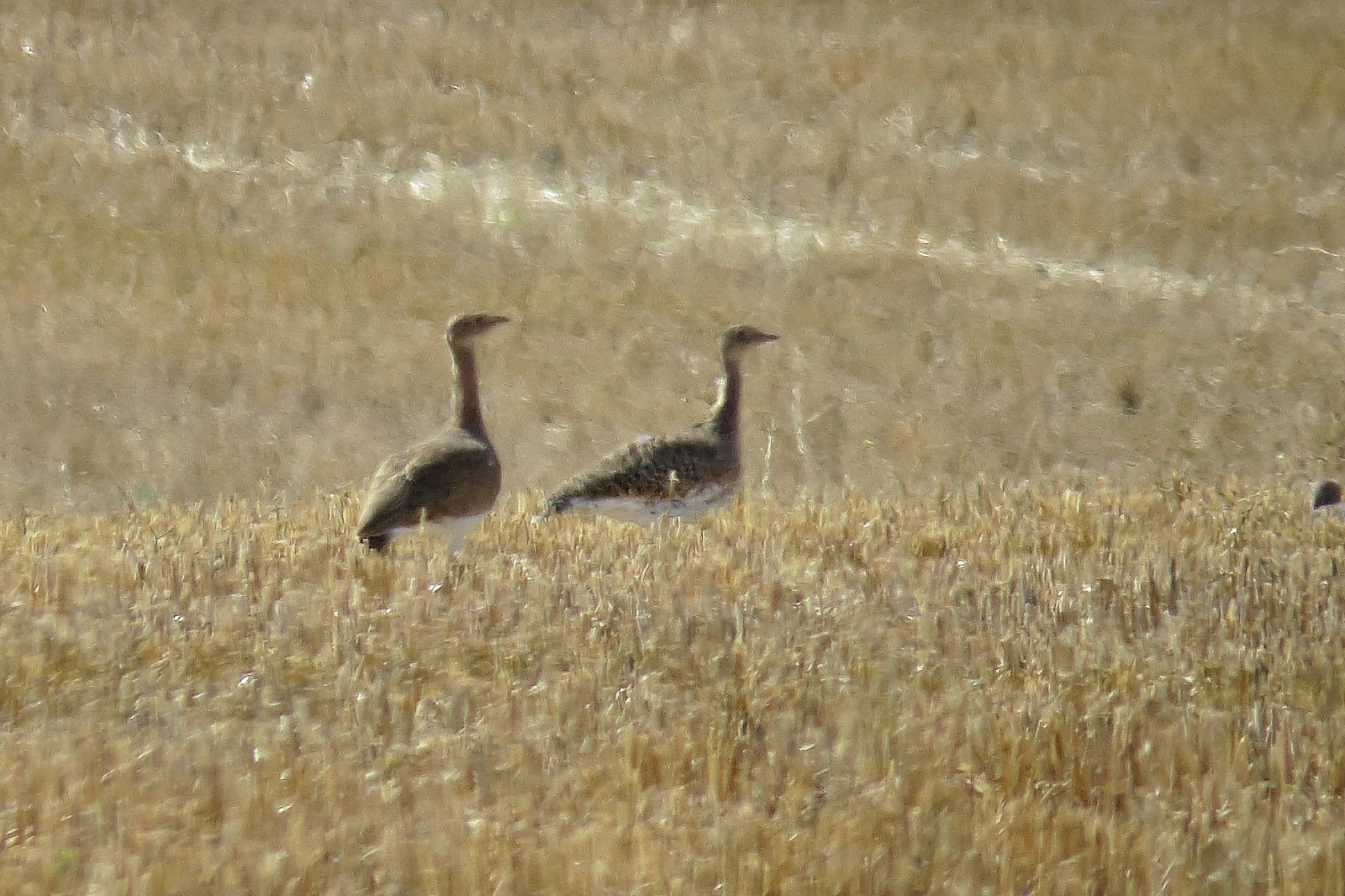Hola a todos una vez más.
Hi once again.
En esta ocasión os muestro algunas de las aves que hemos podido ver en Castilla la Mancha durante dos días de excursión para observar aves esteparias. En ambos días el tiempo fue regular, sobretodo el primer día, pero disfrutamos mucho con las aves que pudimos observar.
This time I show you some of the birds we have seen in Castilla la Mancha during two days tours searching Steppe Birds. On both days the weather was not very good, especially the first day, but we enjoyed the birds we watch.
Como podréis observar por las fotos que he puesto cada día en el campo es distinto y no solo lo digo por las especies que pudimos observar si no también por que el segundo día estaban más asustadizas que el primero. Quizás debido a que el segundo hacia más viento. Los lugares visitados eran los mismos.
As you can observe from the photos I've put field every day is different and not just I say it for the species that we saw but also because the second day Birds were more elusive than the first one maybe because the second was more windy. The places visited were the same.
DIA PRIMERO:
FIRS DAY:
Nada más llegar a la zona de pajareo lo primero que vimos fue un bando de gangas ortega (Pterocles
orientalis).
Upon reaching to our birding area first thing we saw was a flock of Black-bellied Sandgrouses.
Se posaron lejos de nosotros pero las pudimos ver con el telescopio terrestre.
They landed away from us but we could watch them with the telescope.
Esta avutarda común (Otis
tarda) nos ataco por la espalda y la oímos antes de verla.
This Great Bustard attacked us from behind and we heard before seeing it.
Otro bando de gangas ortega (Pterocles orientalis).
Another flock of Black-bellied Sandgrouses.
Había bastantes tarabillas norteñas (Saxicola
rubetra) en paso.
There were quite a few Whinchat in pass.
En este caso el bando era de gangas ibéricas (Pterocles
alchata). En una foto conté 97 ejemplares aunque el bando se había dividido en dos.
In this case the flock was of Pin-tailed
Sandgrouses. In a photo I counted 97 specimens although the flock had split in two.
Otra ave en paso, un águila pescadora (Pandion
haliaetus). Un encuentro inesperado.
Another bird in pass, an Osprey. An unexpected encounter.
Unos sisones comunes (Tetrax
tetrax).
Some Little
Bustards.
Otros en vuelo.
Some others flying.
Un grupo de avutardas comunes (Otis tarda) descansando al sol.
A group of Great Bustards resting in the sun.
Mochuelo europeo (Athene
noctua).
Little
Owl.
Collalba gris (Oenanthe
oenanthe) en plumaje de invierno.
Northern
Wheatear in winter plumage.
Avutarda común (Otis tarda).
Great bustard.
Sisón común (Tetrax tetrax).
Little bustard.
Un bando de sisones comunes (Tetrax tetrax) pasó cerca nuestro y se posó a menor distancia que los anteriores.
A flock of Little Bustards went near us and landed closer than the previous.
Este búho Campestre (Asio
flammeus) nos cogió por sorpresa.
This Short-eared Owl caught us by surprise.
Pero tuvo la amabilidad de posarse cerca para nuestro disfrute.
But it was kind enough to perch close for our enjoyment.
Vimos varios grupos de perdices rojas (Alectoris
rufa).
We saw several groups of Red-legged Partridges.
Gangas ibéricas (Pterocles
alchata).
Pin-tailed
Sandgrouses.
Otras más lejanas.
Some others farther away.
Las lavanderas boyeras (Motacilla
flava) estaban comiendo hormigas con alas.
The Yellow
Wagtail were eating ants with wings.
El alimento antes mencionado.
The food mentioned above.
Avutardas comunes (Otis tarda).
Great bustards.
Un grupo de Gangas ibéricas (Pterocles alchata).
A group of Pin-tailed Sandgrouses.
Había gran cantidad de ánades reales (Anas
platyrhynchos) en los rastrojos alimentándose.
There were lots of Mallards feeding in the stubbles.
Y antes de irnos pudimos disfrutar de un buen grupo de gangas ibéricas (Pterocles alchata).
And before we left we could enjoy a nice group of Pin-tailed Sandgrouses.
Preciosas aves.
Beautiful Birds.
DIA SEGUNDO:
SECOND DAY:
Mientras esperaba a los clientes llamó mi atención este halcón peregrino (Falco
peregrinus) urbanita.
While waiting for customers caught my attention this urban Peregrine Falcon.
Ya en nuestro destino vimos varios cernícalos primilla (Falco
naumanni). En la foto un macho.
Already in our destiny we saw several Lesser Kestrels. Pictured a male.
Y otro más.
And another one.
Impresionante el bando que se levantó de gangas ibéricas (Pterocles alchata) al paso de un aguilucho lagunero occidental (Circus
aeruginosus).
Impressive the flock that rose of Pin-tailed Sandgrouses due to the pass of a Eurasian Marsh Harrier.
En una de mis fotos he llegado a contar 197 individuos aunque no se si estaban todos los que volaban.
In one of my photos I have counted 197 individuals but I ignore if they were all.
Tarabilla norteña (Saxicola
rubetra).
Whinchat.
Sisones comunes (Tetrax tetrax).
Little Bustards.
Collalba gris (Oenanthe
oenanthe).
Northern
Wheatear.
Lavandera boyera (Motacilla
flava).
Yellow
Wagtail.
Bisbita campestre (Anthus
campestris).
Tawny
Pipit.
Este joven de águila imperial ibérica (Aquila
adalberti) nos entretuvo un buen rato y al final fue hostigada por un cernícalo.
This young of Spanish Imperial Eagle entertained us for a while and at the end was harassed by a Kestrel.
Avutardas comunes (Otis tarda).
Great Bustards.
Otros sisones comunes (Tetrax tetrax).
Some others Little Bustards.
Lavandera boyera (Motacilla flava).
Yellow Wagtail.
La verdad es que cada día de pajareo es distinto y creo que eso lo hace aun más atractivo.
The truth is that every birding day is different and I think that makes it even more attractive.
Hasta la próxima entrada.
Until next post.

























































Espectaculares esos bandos, tanto de Gangas, Gangas ortega y también de Sisones. Me encanta ver esas esteparias, que no podemos disfrutar por aquí.
ResponderEliminarSaludos desde Donosti
Alfredo
Gracias Alfredo. La verdad es que es una pasada lo de las esteparias por el centro Peninsular. Ya siento yo no poder disfrutar de las Atlánticas tanto como a mí me gustase.
EliminarUn saludo.